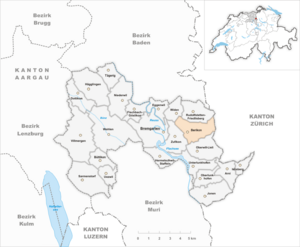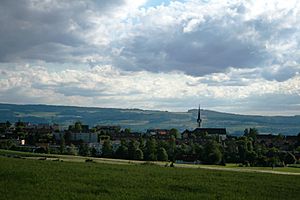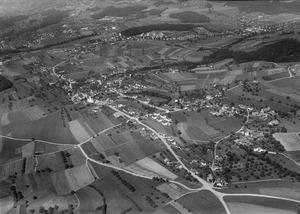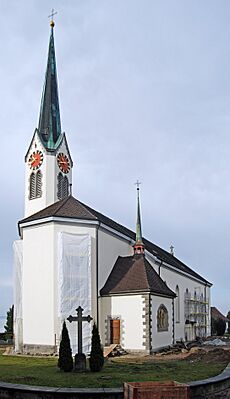Berikon facts for kids
Quick facts for kids
Berikon
|
||
|---|---|---|
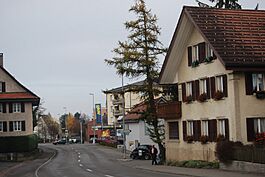 |
||
|
||
| Country | Switzerland | |
| Canton | Aargau | |
| District | Bremgarten | |
| Area | ||
| • Total | 5.38 km2 (2.08 sq mi) | |
| Elevation | 556 m (1,824 ft) | |
| Population
(Dec 2020 )
|
||
| • Total | 4,749 | |
| • Density | 882.7/km2 (2,286.2/sq mi) | |
| Postal code |
8965
|
|
| Surrounded by | Birmensdorf (ZH), Oberwil-Lieli, Rudolfstetten-Friedlisberg, Widen, Zufikon | |
| Twin towns | Würenlingen (Switzerland) | |
Berikon is a town in Switzerland. It is located in the canton of Aargau, which is like a state in Switzerland. Berikon is part of the Bremgarten district.
This town sits on a hill. It is found above and to the east of the Reuss Valley. Berikon also covers part of the Mutschellen Pass, which is a mountain pass. The towns next to Berikon are Rudolfstetten-Friedlisberg, Widen, Zufikon, and Oberwil-Lieli. It also shares a border with the Canton of Zürich.
Contents
History of Berikon
Berikon was first mentioned way back in 1153! It was called "Berchheim" then. Later, in 1184, it was known as Berchein. Over time, its name changed a few times. It went from Berchheim to Bergheim, then Berchan, Berkein, and finally, Berikon.
The town used to have two separate parts: Unterberikon (Lower Berikon) and Oberberikon (Upper Berikon). In 1415, the city of Zürich took control of these areas. This happened when the Eidgenossen (which means "Confederates," referring to the Swiss Confederacy) took over Aargau. Later, in 1471, the two parts were governed by different local offices.
In 1798, the French army came into Switzerland. They created a new government called the Helvetic Republic. During this time, both parts of Berikon became part of the short-lived canton of Baden. Then, in 1803, the canton of Aargau was formed. The two parts of Berikon were finally reunited and joined the Bremgarten district.
On May 1, 1902, a train line called the Bremgarten-Dietikon-Bahn opened. This gave Berikon a railway connection to other parts of Switzerland. Even with the train, Berikon was a small farming village for a long time. In 1950, only about 900 people lived there. But then, a big building boom happened! In just 30 years, the number of people living in Berikon grew by more than 150%. Today, the population is about four times what it was in the 1960s. Berikon has grown so much that it is now part of the larger Zürich area.
What is Berikon like?
Berikon covers an area of about 5.4 square kilometers (about 2 square miles). Almost half of Berikon's land (49.7%) is used for farming. About a third (31.4%) is covered in forests. The rest of the land (18.9%) is where people live and build things.
The town is located on the Mutschellenhöhe, which is a high point or hill. It is made up of the two original villages, Ober-Berikon and Unter-Berikon, which have now grown together.
Berikon's Coat of Arms
Berikon's coat of arms shows a green clover leaf on a silver background. This design is the official symbol of the town.
People of Berikon
At the end of 2008, Berikon had 4,491 residents. About 13.2% of these people were not Swiss citizens. Slightly more than half (50.2%) of the residents were female. As of 2022, Berikon had 4,809 people living there. About 13.9% of the population were foreign nationals.
Most people in Berikon speak German (92.6%). Italian is the second most common language (1.6%), followed by French (1.0%).
The population has grown slowly over the last 10 years, at a rate of about 0.9% per year.
Age Groups in Berikon
In 2008, here's how the age groups looked:
- Children (0-9 years old): 10.2%
- Teenagers (10-19 years old): 11.5%
- Young adults (20-29 years old): 12.9%
- Adults (30-39 years old): 14.5%
- Adults (40-49 years old): 18.1%
- Adults (50-59 years old): 14.5%
- Seniors (60-69 years old): 10.8%
- Seniors (70-79 years old): 5.3%
- Seniors (80-89 years old): 1.9%
- Seniors (90 and older): 0.3%
Homes in Berikon
In 2000, the average home had 0.56 people per room. About 34.9% of homes were owned by the people living in them. In 2000, there were:
- 127 homes with 1 or 2 people
- 952 homes with 3 or 4 people
- 684 homes with 5 or more people
The average household had 2.40 people. In 2008, there were 548 single-family homes. This was about 27.5% of all homes and apartments. Only 0.9% of apartments were empty. In 2007, new homes were being built at a rate of 0.5 new homes for every 1000 residents.
Population Growth Over Time
Here's how Berikon's population has changed over the years:
| Historical population | ||
|---|---|---|
| Year | Pop. | ±% |
| 1850 | 549 | — |
| 1900 | 701 | +27.7% |
| 1950 | 900 | +28.4% |
| 1970 | 1,593 | +77.0% |
| 2000 | 4,358 | +173.6% |
Religion in Berikon
According to the 2000 census:
- 2,030 people (46.6%) were Roman Catholic.
- 1,545 people (35.5%) belonged to the Swiss Reformed Church.
- A very small number (3 people) belonged to the Christian Catholic faith.
How Berikon is Governed
The laws in Berikon are made by the Gemeindeversammlung, which is like a town meeting. All citizens can attend and vote on local issues.
The town is run by a five-member Gemeinderat (town council). The members of this council are elected for a four-year term. The Gemeinderat leads the village and carries out tasks set by the town meeting. They also handle duties given by the canton and federal governments.
Small legal problems are handled by the Friedensrichterkreis of Bremgarten. This is similar to a Justice of the Peace.
In the 2007 federal election, the most popular political party in Berikon was the SVP. They received 34.2% of the votes. The next most popular parties were the SP (18.7%), the CVP (18.1%), and the FDP (14.1%).
Education in Berikon
In Berikon, about 84.7% of adults (aged 25–64) have completed high school or gone on to higher education, like university.
In the 2008/2009 school year:
- 334 students were in primary school.
- 312 students were in secondary school.
- 284 students were in university-level schooling.
Berikon has its own primary schools, from kindergarten up to intermediate school (grades 6 to 9). The closest higher secondary school, called a Kantonsschule, is in Wohlen.
Economy and Jobs
In 2007, Berikon had a low unemployment rate of 2.46%.
In 2005, jobs in Berikon were divided into three main types:
- Primary sector (farming, fishing, etc.): 85 people worked in this sector, with 22 businesses.
- Secondary sector (manufacturing, construction): 142 people worked here, with 33 businesses.
- Tertiary sector (services like shops, offices, healthcare): 956 people worked in this sector, with 191 businesses.
In 2000, 2,504 people who lived in Berikon had jobs. Most of them (81.3%) worked outside of Berikon. However, 644 people came into Berikon to work. There were 1,111 jobs available in the town.
When people traveled to work:
- 19.5% used public transportation (like trains or buses).
- 56.9% used a private car.
Many people who live in Berikon travel to jobs in the city of Zürich or nearby towns like Dietikon, Spreitenbach, and Schlieren.
Transportation
The Berikon-Widen station is part of the Bremgarten-Dietikon-Bahn train line. This station is located right on the Mutschellen pass. It is a stop for the S-Bahn Zürich train line S17.
Buses also serve Berikon. Two Postauto bus lines start at the Berikon-Widen station. They connect the Mutschellen communities with Baden to the north and Zürich to the east. The No. 350 Postauto bus line to Zürich also connects well in Birmensdorf with the S9 and S15 train lines, which go to Zürich, Affoltern am Albis, and Zug.
Before the A1 expressway was built, the Mutschellen pass was the main road between Zürich and Bern. Today, the road to Bern (called Bernstrasse or Hauptstrasse 1) is still important for cars, especially for people traveling to work.
A new expressway, the A4, was finished in November 2009. This means more traffic is expected to pass through Berikon, especially for travelers heading to the interchange at Birmensdorf (about 3 km away). Berikon has started road construction projects to help reduce the amount of traffic passing through the town. These projects were planned to take about 2.5 years and were completed in autumn 2011.
See also
 In Spanish: Berikon para niños
In Spanish: Berikon para niños





